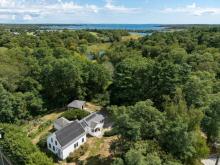Last year’s drought improved ocean health, but it will be short-lived, experts say
Drought conditions may have hurt Dartmouth’s farmers last summer, but conservation experts have found that the lack of rain actually helped water quality around Buzzards Bay.
Throughout the summer, Buzzards Bay Coalition volunteers measured water quality indicators — including water clarity, dissolved oxygen, temperature, and salinity — every five days. The result was the recently released Bay Health Report, which concluded that drought conditions prevented an algae overload in the bay this past year. However, scientists expect that this year’s record rainfall may reverse that.
“The thing about the drought year is we have less rain. When it rains, we have runoff nitrogen from roads and lawns,” explained the Coalition’s Science Director Rachel Jakuba.
Nitrogen — which is a byproduct in septic systems, and is also found in fertilizers — encourages plant growth, including algae blooms that can turn the water murky. Massive algae blooms deplete oxygen stores in the water, which can result in fish kills. They also prevent sunlight from reaching photosynthesizers like eelgrass on the seafloor, consequentially destroying the habitats for shellfish and some fish species.
“[Last year,] there was nitrogen being deposited on the watershed, but it was staying on the land. It will make it to the water this year with the amount of rain. We’re expecting it to translate to algae and not great water quality,” said Jakuba.
Of the Coalition’s eight testing sites in Dartmouth, four had poor water quality ratings for the past year — Apponagansett Bay, Little River, Slocum’s River, and Salters Pond.
“There’s been a lot of work done to try to figure out how much nitrogen is going into Apponagansett Bay, Slocum’s River, and Little River. It’s all the sources we’ve already talked about — old septic nitrogen, runoff from roads,” said Jakuba.
In addition to rain, abnormally warm weather can contribute to algae blooms, said Jakuba. Before last year, 2012 was the last time widespread rusty tide overtook the bay, according to the Coalition’s website. Rusty tide is seen as red-brown bands in the water, like the ones that appeared in Apponagansett Bay last summer. Before last year, 2012 also held the record for highest average annual temperature, according to the site.
“Algae need nitrogen to bloom, but that’s not the only thing,” Jakoba said. “We don’t understand exactly how all the factors fit together to make the year a bloom year. When we have high temperatures on top of the nitrogen concentrations, we see these blooms.”
Of the remaining sites, Allens Pond, Clarks Cove, and Nonquitt Marsh had fair ratings for water quality. Round Hill is only tested for dissolved oxygen and water clarity, so it is not given a rating.
“One of the things going on with Allens Pond — so much of the [surrounding] land is protected. There’s not as many homes in the watershed. There’s pretty dense population around Apponagansett Bay and Slocum's River,” said Jakuba.
Jakuba explained that rain also pulls nitrogen out of the air and deposits it in the oceans. The way this works is nitrogen released from vehicles and power plants can stick to air particles, and are then carried into the ocean similarly to land runoff, Jakuba said.
“[Nitrogen pollution is] the largest, long-term threat to Buzzards Bay, which is why we focus on that one,” said Jakuba. She said that every four years, the Coalition completes a comprehensive “State of Buzzards Bay” report, which also looks at toxic pollution and living resources.
While the drought generally improved the bay’s water quality — with rusty tides being the exception, it had the reverse effect on freshwater rivers. Water levels lowered, which caused the water to heat up faster and waters to become more stagnant, according to the website. This also means that there were lower levels of oxygen available to creatures below the water’s surface.
Overall, twice as many water quality scores for the bay’s harbors, coves, and rivers improved in 2016, compared to those that got worse or stayed the same, according to the Coalition’s website. About half of the Buzzards Bay waterways were rated “fair,” while just under one third of the waterways are considered in “good” condition. The rest were labeled with “poor” water qualities because of unhealthy underwater habitats and too much pollution, according to the website.
Every summer, about 130 volunteers participate in the Baywatchers program, and a Bay Health Report is released with the collected data, said Jakuba. The watch program has been ongoing for about 25 years.














